Nabemashou! That was the first Oyaji-Gag I ever made. Like all the worst jokes, it requires explanation. The verb ending -mashou is usually translated as "let's verb". For example, tabemashou 食べましょう! Let's eat! Nabe 鍋 means pot in Japanese. It also refers to a style of home-cooking, which unsurprisingly is done in a pot. Although it is completely ungrammatical, I combined nabe and -mashou. Nabemashou! Let's nabe! Feel free to groan.
Once you've got over my terrible sense of humour, seriously let's nabe. If you don't know how to nabe, get ready to learn. This guide has everything you need to get started.
What is Nabe?
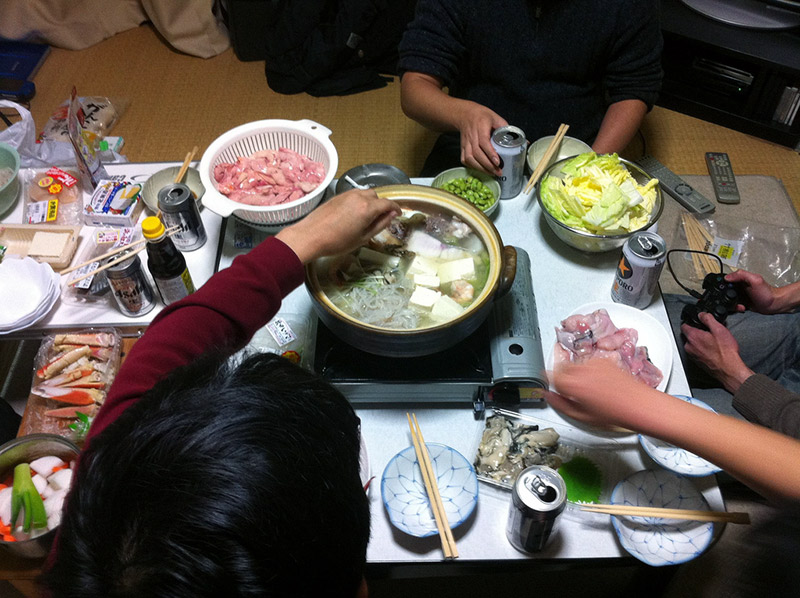
Nabe is a style of cooking you don't often see alongside the sushi and noodles in Japanese restaurants outside Japan. However there are many restaurants in Japan that specialise in the various nabe styles. The styles of nabe I'm going to focus on here are the ones that are often home-cooked. In fact, I believe nabe is the best home-cooked dish. Having people over for nabe is a communal experience. You all work together, cooking the food at the table. Unlike hosting a dinner party, no one is trapped in the kitchen preparing food. You can all enjoy cooking and each other's company at the same time. My friends and I often went out to eat together, but when we went to each other's houses we almost always made nabe. For me nabe represents good times relaxing with friends. It certainly doesn't hurt that nabe is really delicious. It's also very warming and was always the food highlight of Hokkaido's harsh winters.
There are many different types of nabe pots and different dishes that can be cooked in these nabe. These are called nabemono 鍋物. Sukiyaki, shabu shabu and oden are all nabemono. Each uses a different type of pot. Today, I'm going to be focusing on cuisine made in a donabe 土鍋 pot, the kind that is most easily made at home. Tetsunabe 鉄鍋 or iron pot nabe are a whole other delicious category. You can also make many other kinds of dishes, such as mabodofu, stews, and rice in your donabe. But today were just going to be focusing on one style of donabe cooking.
Gathering Nabe Supplies
If you want to try making nabe at home, you're going to need some equipment. Here are the basics:
A donabe pot 土鍋
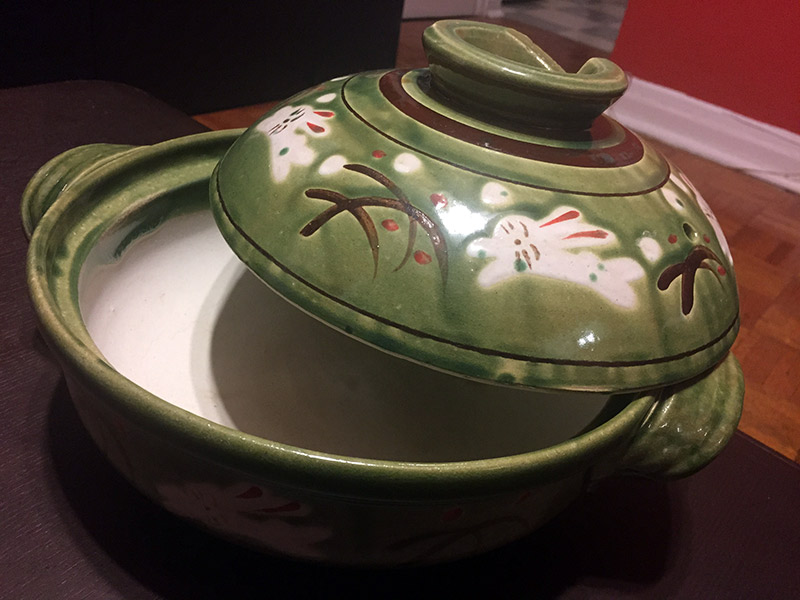
You can find donabe in various sizes and designs. The sizes are usually described by the number of people you can feed from one. For example, you can find a 1-2 person nabe, all the way up to a 12-14 person nabe, or even larger. They are made of very heavy ceramic that retains the heat well. Donabe literally means earth pot. For safety's sake, it is best to use a real donabe, not any other ceramic pot. This is because donabe are specially constructed for cooking over an open flame. Properly cared for, a donabe will last generations. Traditionally, the older a donabe is, the better is for cooking delicious food.
A portable gas burner
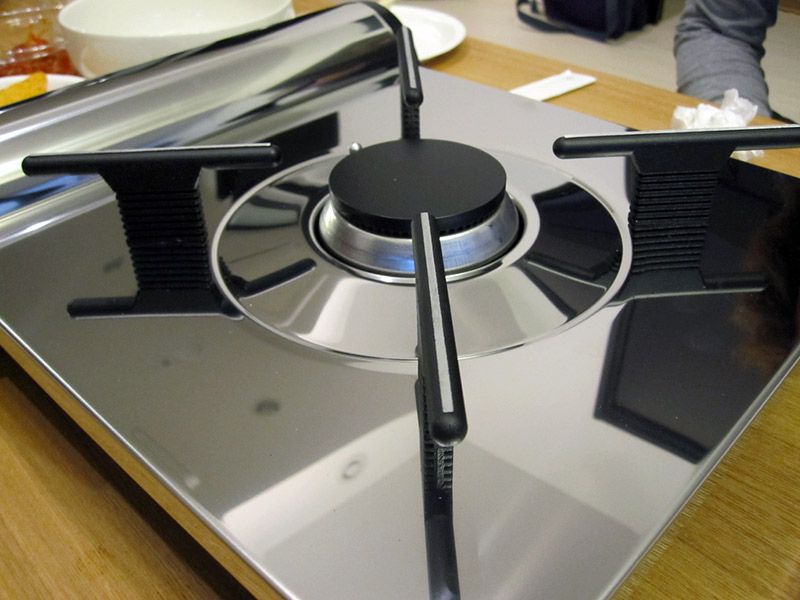
This is the key item that takes nabe from a delicious dish that you could make on your stove to a communal interactive experience. This is a bit like a campstove, but one that can be used indoors. Mine came in a handy carry case. It is fuelled by gas canisters. One usually lasts for one or two nabe parties. You should look for one with a good stable base, a variable flame, and specifically designed for nabe cooking.
Alternative: Electric nabe
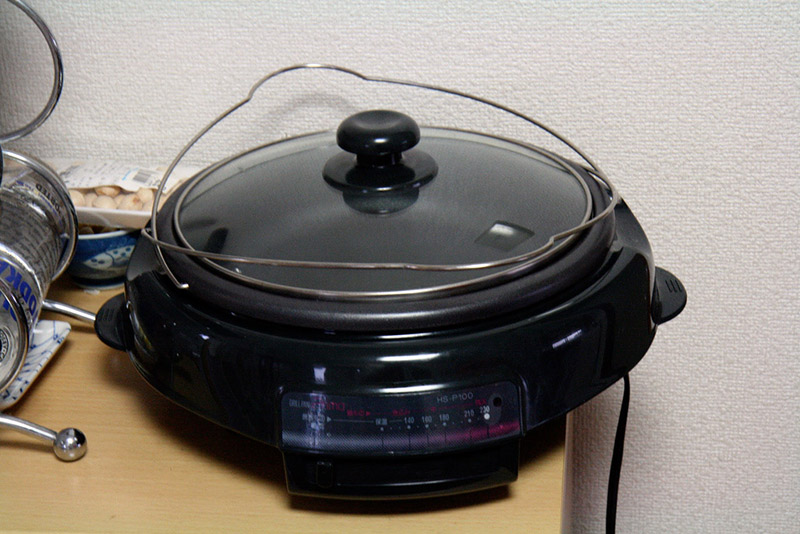
Of course nabe have been gadgetised. Often called an electric skillet, you can use these if you aren't comfortable cooking with an open flame, or prefer the convenience. The communal cooking at the table principle is the same. Some of these double as steamers or fondue pots.
Where to buy
If you are in Japan, nabe stuff is easy to find. Go to the cookware department of any home store or large supermarket and you should be able to find nabe pots of various sizes as well as burners and gas canisters. If you aren't in Japan, you can still find nabe equipment, but it may take some footwork. After three months of living in Canada nabe-less, I couldn't take it anymore. I found a nabe pot and burner in a tiny Korean supermarket for about $50. There is also the internet. A quick search brings up dozens of donabe and burners.
Most of the ingredients for nabe are easily found in supermarkets, asian supermarkets, or online. You shouldn't have to spend a lot of money as, with a few exceptions, they are fairly common. Of course, it's easier if you're living in Japan. There you can buy the ingredients for a nabe in a kit at most supermarkets. They even cut up the vegetables for you!
Step by Step Nabe Cooking for Beginners
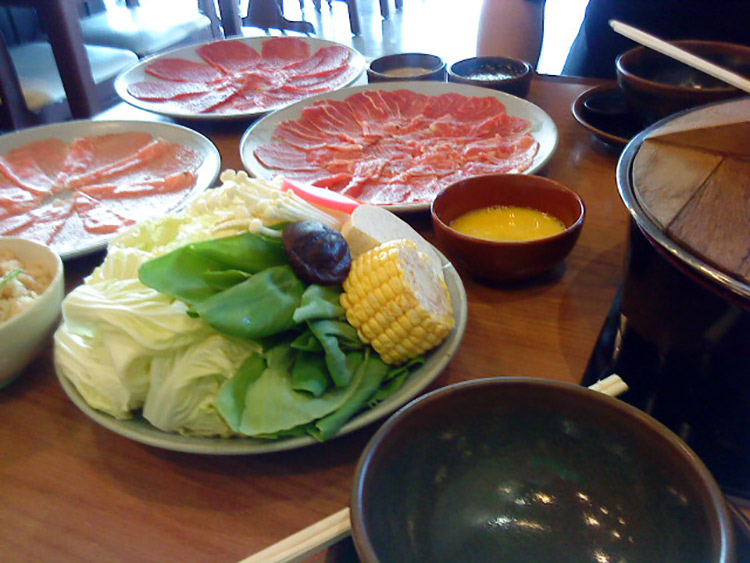
The method of cooking nabe is easily mastered. Here are the steps that you can apply to almost every style of donabe cooking.
- Prepare your ingredients (scroll to the bottom for recipes). Cut everything into bite sized pieces.
- Prepare your soup base. This can be one you made yourself or store bought. Mix the liquid ingredients and stir until any that need to be dissolved (miso, sugar etc.) have done so.
- Arrange your ingredients and base in the donabe. The base should fill the nabe about 2/3rds full with the ingredients in it.
- Put the lid on.
- Heat your nabe. I was taught to heat the nabe to boiling on the stove before taking it to the table. This saves the gas canisters and you get to eat quicker.
- Carry the nabe to the table and place it on the portable gas burner. Continue heating.
- Eat! Everyone can scoop out their own delicious nabe bits using a ladle or big spoon.
- Add more ingredients. If an ingredient starts running out, add more! This counts for everything including the base. Be careful to let any added meat cook through before continuing to eat.
- When all the ingredients are eaten up, add rice or noodles to the base and cook them.
- Eat again!
- Roll around with happiness.
Refining Your Nabe Skills
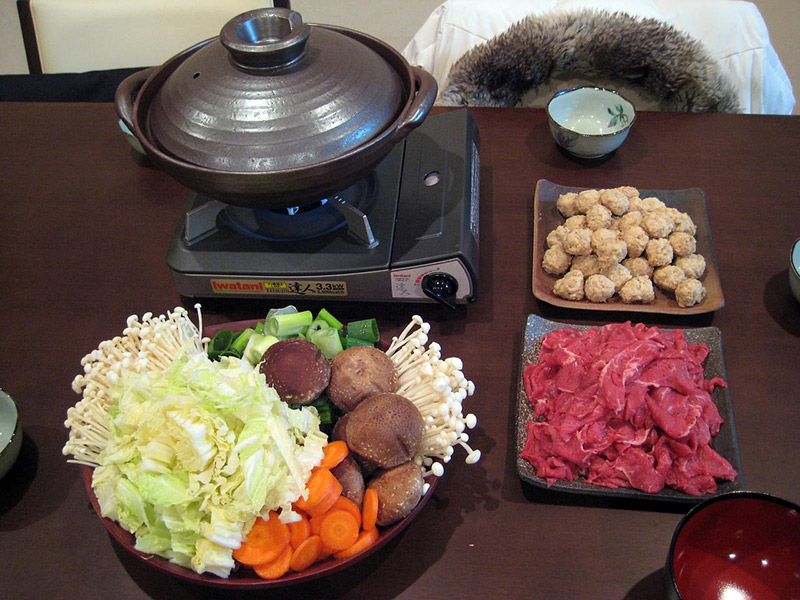
With the basic nabe cooking method under your belt, here are a few tips and tricks that help make the experience even more amazing.
The key to cooking meat in a nabe is to use thin slices. This helps it cook quickly and reduces the risk of eating undercooked meat. If you're in Japan or you can get to a speciality Japanese, Chinese or Korean supermarket, you'll easily find meat sliced specially for nabe (and its Chinese and Korean counterparts.) However, if you can't buy it, there is still a way for you to get beautifully thin sliced meat. All you need is a freezer and a good knife. Put the meat you want to slice in the freezer for about half an hour. This will make it firm enough for you to cut into thin slices, without compromising the integrity of the meat.
You can make all sorts of different nabe cooking bases. The most basic ones are made from dashi, soy sauce and miso. However, you could experiment with chicken stock, Japanese curry, soy milk, or tomato sauce. Anything goes really.
After you've scooped out all the delicious bits and bobs from your nabe, you'll be left with a flavoursome stock. It would be a shame to waste it. That's why some nabe are finished off by adding noodles or rice to the stock. Personally I like to use a packet of fresh soba, but if you don't have any to hand, even a packet of instant noodles will do. This is a hearty way to finish off your nabe. The only danger is that you'll be too stuffed to enjoy it!
You can level up your presentation by cutting your vegetables into fancy shapes. Carrorts cuts into flowers are a big hit. Unless you have mad knife skills, the easiest way to do this is get a special carrot cutting stamp. You can find these wherever things for prettying up bento boxes are sold, or online here.
With proper care, your donabe should last for decades. Indeed, the older a donabe is, the better the nabe you cook inside it will be, or at least so the tradition goes. When you first get your donabe, you should 'season' it.
- Start with your donabe completely dry.
- Pour in boiling water until it is about 3/4s full and add cooked short-grain rice. You should add enough to make a thick porridge.
- Stir it thoroughly and put on the lid. Heat gently, stirring occasionally so it doesn't stick to the bottom. The rice and water should turn into a kind of paste. Don't let it boil.
- After about half an hour, turn off the heat and let the rice paste cool for an hour.
- Next throw away the rice paste and rinse the donabe thoroughly. You must let the donabe dry completely before using it.
- Never use a wet donabe, as if the clay at the bottom is wet, it could crack.
You can wash your donabe with normal dish soap. Don't put it in a dishwasher though! Be sure to dry it carefully and leave it upside down before storing it so that the bottom is completely dry. If you have any leftovers, don't leave them in the donabe. You don't want it to start smelling funky. If it does, you can freshen it up by boiling green tea or a white vingeager and water mixture in it for 10 minutes.
There are no hard and fast rules to cooking nabe. Taste as you go to suit yourself. Personally I don't like adding sugar to my nabe, even though many recipes call for it. I'd recommend taste being your guide rather than a sense of "authenticity." The most authentic thing about nabe is sharing it with friends.
Nabe Highlights
Now that you have a good nabe foundation, let's explore. There are all kinds of nabe to be found in Japan. Here's some examples to inspire your experimentation.
Chankonabe ちゃんこ鍋
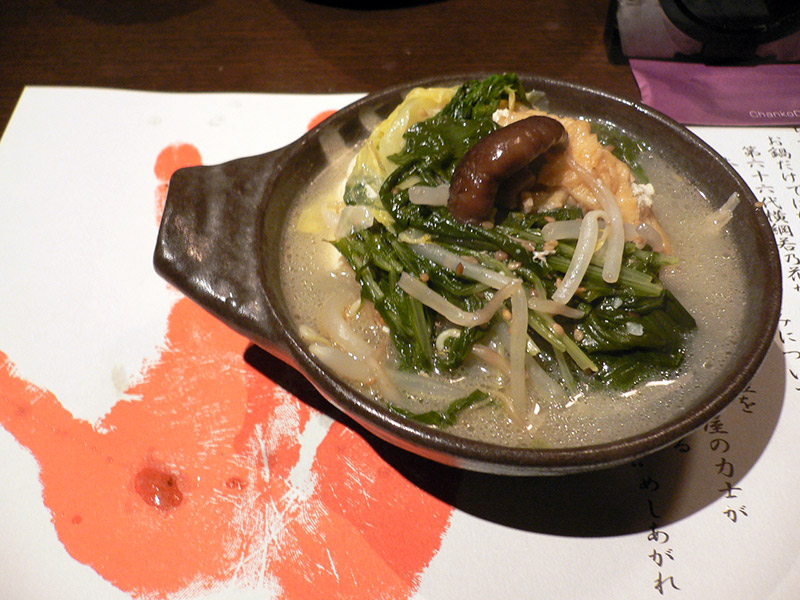
If you have an interest in sumo, you might have heard about this nabe. Chankonabe is the traditional food eaten by sumo wrestlers to gain weight. The main ingredients are chicken, vegetables and a soy or miso broth. It is said that chicken is used rather than pork because sumo wrestlers should always be on two feet like a chicken, not four like a pig. However, this is more tradition than reality these days as sumo wrestlers often eat pork or fish in their nabe too. However, chicken is still the most popular before matches or as a celebration. Different sumo stables have different recipes. Chankonabe can easily be cooked in the large quantities sumo wrestlers need to produce their distinctive size. It is the job of junior wresters in a sumo stable to prepare the meal.
If you'd like to try this dish, you're in luck. Many retired sumo wrestlers set up chankonabe restaurants. The first and most traditional of these is Kawasaki Chanko, set up in 1937 by former wrester Yokoteyama in the heart of Tokyo's sumo land.
Botannabe ぼたん鍋
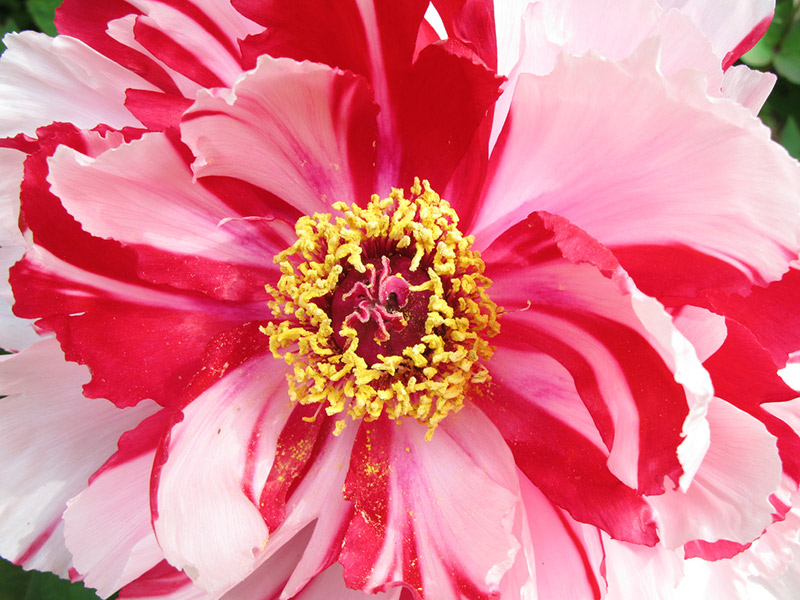
Botan means peony, but this nabe doesn't contain flowers. Peony is an euphemism for wild boar meat. This nabe is popular in mountainous areas of Gifu and Hyogo Prefectures. The wild boar meat is paired with root vegetables, mushrooms, konjac (AKA Devil's Tongue, AKA コンニャク) and tofu. The base often has a lot of soy sauce, sugar and thick hacchou miso. If you can't get your hands on wild boar meat, you could substitute pork.
Inouenabe 井上鍋
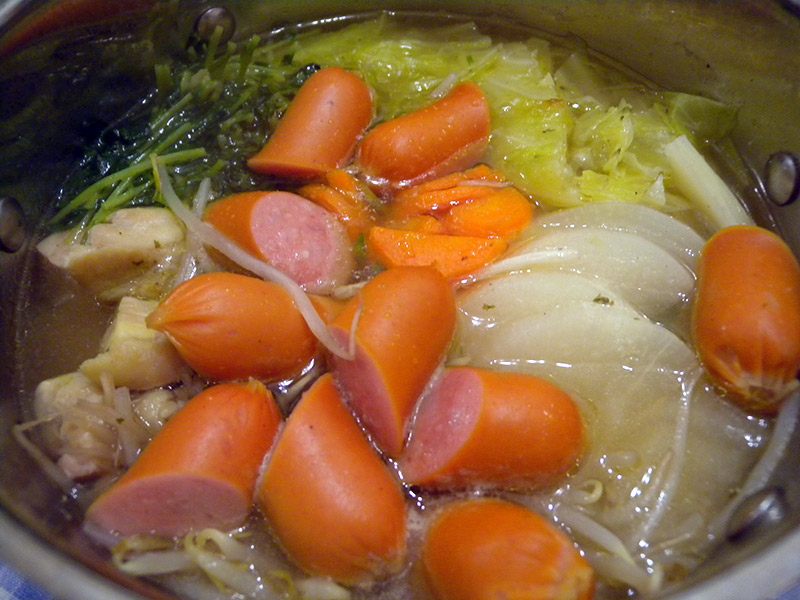
Inouenabe is a modern nabe recipe, that has gained recent popularity since 2006. The ingredients are simple, chicken, bean sprouts, cabbage and red 'wiener' sausages that are more often seen in kid's bento boxes than in nabe. The base is what makes this nabe different. It uses yakiniku sauce. Yakiniku is delicious on its own, but the sauce can add a depth to nabe too. Inouenabe base is now produced commercially, but you can replicate it by putting a hefty splash of yakiniku sauce into your nabe.
Motsunabe もつ鍋
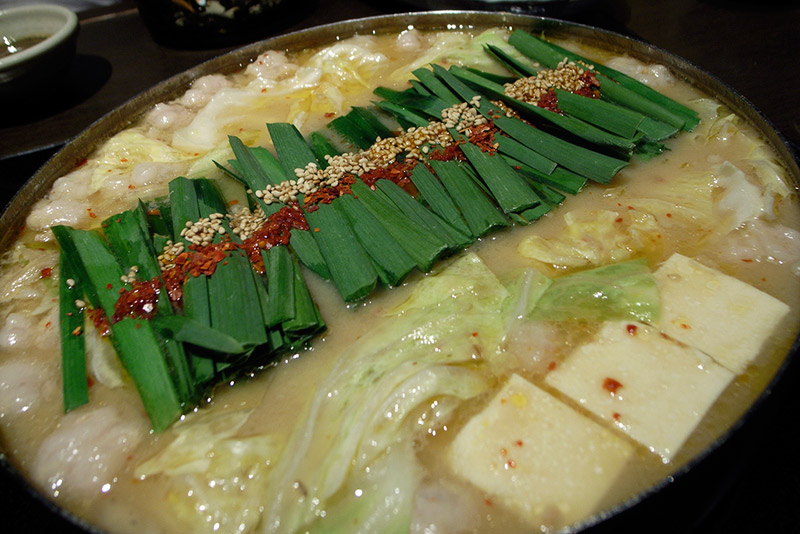
Mmmm… intestines. I would be failing in my duties as someone who writes about… unusual food if I didn't share motsunabe with you. Hiding under that neat row of garlic chives is some (delicious?) pig or cow guts. Originally from Fukuoka, motsunabe has now spread nationwide. Some heavy seasoning with garlic, and chili pepper helps make it slightly more palatable than you might expect.
Nekonabe 猫鍋
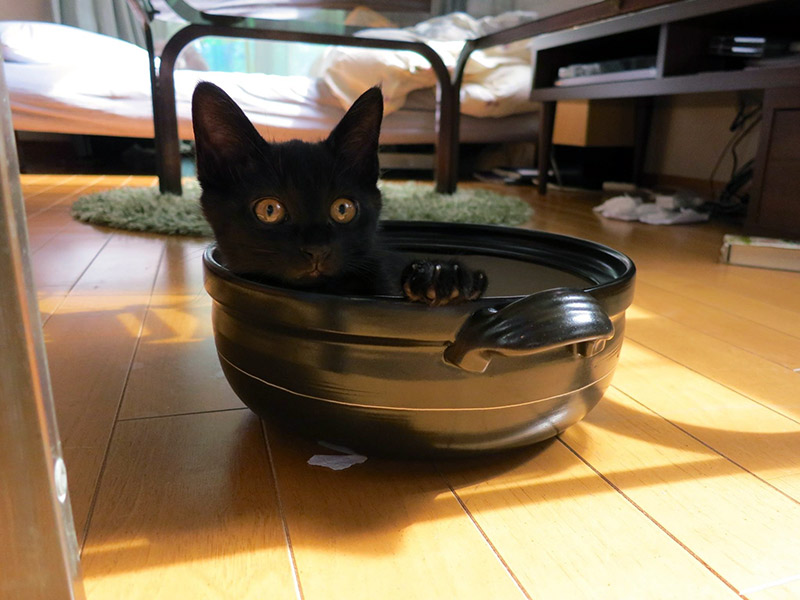
This one's not for eating! Just for squeeing! Nekonabe, or cats in nabe, went viral in Japan a few years back. You can see why, they are just so darned cute. If you want to go on an adorable voyage into the cute parts of the internet, Google nekonabe or 猫鍋 and prepare to be entertained.
Nabe to Try at Home
Do you finally feel ready to tackle some nabe recipes? Don't worry. I believe in you.
Ishikarinabe 石狩鍋
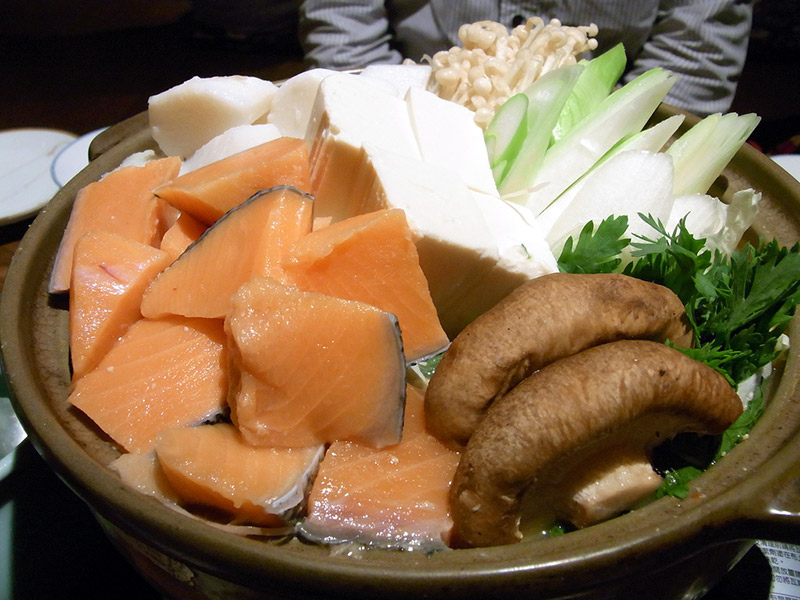
Hokkaido! Land of salmon! Land of potatoes! In 2007 Ishikarinabe was designated the local dish representing Hokkaido. It's easy to see why, as it contains many of the ingredients that Hokkaido produces. It also includes several non-traditional Japanese ingredients like butter and potatoes, which reflects both the era in which Hokkaido was settled and when the dish was created. Ishikarinabe has a very different character than other nabe on this list thanks to its main ingredient being fish. The base is miso and milk (another Hokkaido speciality), and is often added to bring out the buttery nature of the salmon. The salmon is simply gutted, cleaned and cut into chunks, large bones and all. There are different varieties based on the age and sex of the salmon being used. Here is a basic recipe if you'd like to try it yourself. The quantities will depend on the size of the donabe you're using.
Base
- Miso
- Dashi stock
- Mirin
- Cooking sake
- Milk (to taste)
Ingredients
- Raw salmon, ideally on the bone
- Daikon radish
- Carrot
- Potatoes
- Chinese cabbage
- Onion
- Shiitake or enoki mushrooms
- Butter
Kimchinabe キムチ鍋
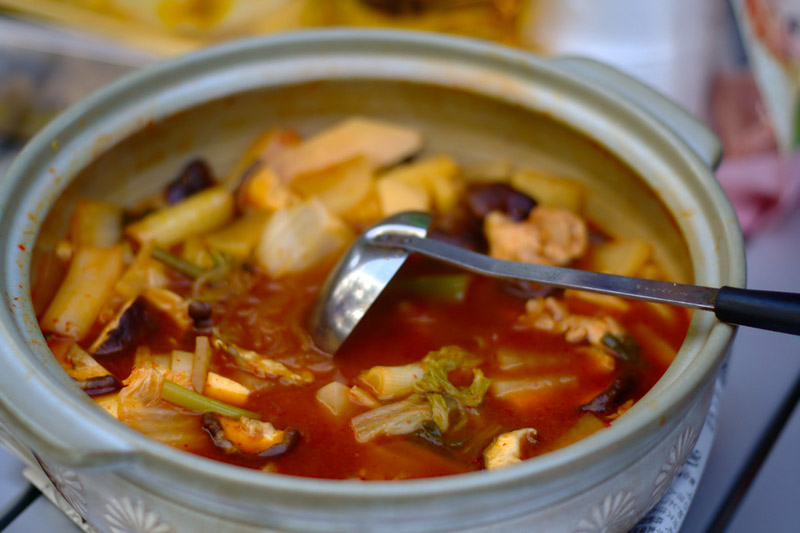
Yes, you caught me. Kimchi is not Japanese, it's Korean. I just had to include this nabe though because it's my favourite and the one that I most often ate in Japan. It was easy to find kimchi stock base in the supermarket there. Now I make my own by using dashi stock and real kimchi.
Base
- Dashi stock
- Kimchi
- Soy sauce
Ingredients
- Pork and ginger meatballs
- Cabbage
- Carrots
- Mushrooms
- Thinly sliced pork
- Garlic chives
Yosenabe 寄せ鍋
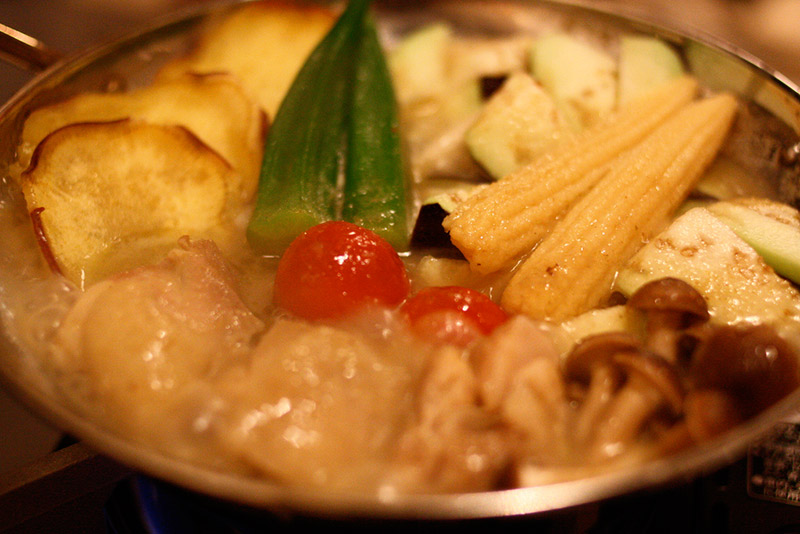
The least strict of all the nabe recipes is yosenabe. Its name can be translated as 'nearest' nabe, meaning the ingredients are whatever you have at hand. Anything you want can go in a yosenabe. Each family's in each region in each season will be different. Once you've got the simple nabe cooking method down, you can vary it to your tastes. Vegetarian nabe? Go for it! Love turnip? Stick it in there! Curry nabe? Sounds like a good idea! Why not look around you and see what your nearest ingredients are that could go in your own yosenabe?
Base
- Whatever you want!
Ingredients
- Whatever! Just throw it in!
Don't be a Nabe Magistrate! Nabe's Place in the Japanese Language

Nabe cooking has been in Japan for a very long time. The earliest evidence of pottery in the world is from Japan and could be considered the ancestor of nabe cooking. Clay + food + fire = good times.
Since the nabe has been around so long, it's not surprising that it has entered the Japanese language in some interesting ways. nabebugyou 鍋奉行 means pot magistrate. This word is used to describe someone who takes it upon themselves to direct the cooking of the nabe. It implies that they are overbearing, telling people what ingredients to add and how fast to eat. Since cooking nabe together is meant to be a communal experience, you can see how this sort of behaviour can be unwelcome. Outside of nabe cooking, 鍋奉行 is also sometimes used to describe someone who demands that things are arranged absolutely their way.
Beyond the pushiness of a nabe magistrate is the rage of a 鍋将軍, a nabe shogun. This is a person who not only dictates how a nabe is cooked, but goes into a rage when they don't get their own way. The power of the nabe shogun is absolute.
There is one more character in this nabe drama. That is the aku daikan アク代官 / 悪代官, the fat skimming evil magistrate. When you cook nabe, some fat rises to the top. This is skimmed off by the aku daikan. The name is a reference to evil magistrates in Japanese plays who are the power behind the throne. As the important step of fat skimming is often neglected, a campaign was started to spread the phrase aku daikan across Japan. Could you be the éminence grise of a nabe?
Go Forth and Nabe!
I hope that this introduction to the delight that is nabe has made your mouth water. While it takes years to train as a sushi chef, nabe is something anyone can cook. It is the most relaxed style of Japanese cooking I know and it's perfect for this cold weather we've been having. Just remember, if someone says, "Nabemashou!" you say, "Yes!"
